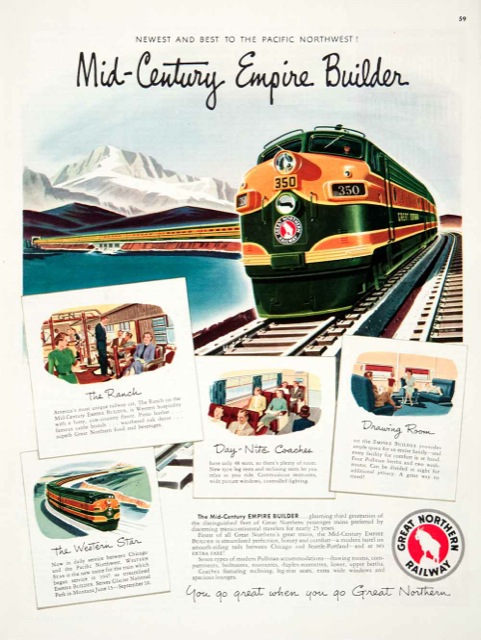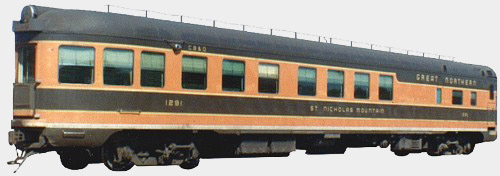Having streamlined the Empire Builder in 1947, the Great Northern Railway demonstrated an optimistic view of passenger traffic when it completely re-equpped it in 1951. This allowed the railroad to use the 1947 trains as a secondary train along the same Chicago-Seattle route.

Click image for a larger view.
The 1947 train was twelve cars long, consisting of a baggage-post office car, four coaches, four sleepers, and three “feature” cars–diners and lounges. The 1951 train added three cars to this consist: a baggage-crew dormitory car and two sleepers. In 1949, shortly before ordering the 1951 Empire Builder, the Great Northern had ordered additional sleeping cars for the 1947 version, so both trains were nominally the same length except for the additional baggage-dorm on the 1951 edition.
While the 1947 train was entirely built by Pullman, for 1951 Pullman built only the sleepers and long-distance coaches, while Great Northern went to American Car & Foundry (ACF) for the short-distance coaches and feature cars. As I’ve previously noted, the 1947 Empire Builder included the most colorful feature cars ever seen in the Northwest. Yet the 1951 cars were even more spectacular.

Click image to download a 2.5-MB PDF of this 24-page brochure. This is not from my collection; instead, it is based on scans of a brochure owned by Lindsay Korst and posted on his Great Northern Railway web site.
First was the “Ranch” car, decorated to look like the interior of a log cookhouse, with “no jarring modernistic touches.” With 14 lunch counter seats and 30 more lounge and dining room seats, this car more than replaced the Hudsons-Bay-blanket-themed car on the 1947 train, which had only 20 seats (as the rest of the car was used for a crew dorm).
The dining car was a modest improvement over the 1947 version, which was decorated with Glacier Park wildflowers on the wall panels between the windows. The 1951 car featured huge glass partitions that divided the car into three sections. Each partition was etched with a scene of industry or agriculture along the route of the Great Northern.

The Mountain-series observation cars had some of the tallest windows on any passenger train at the time. Each car was named after a mountain in Glacier Park: Appekunny, Cathedral, Going to the Sun, Little Chief, St. Nicolas, and Trempeleau.
Saving the best for last, the train’s observation car featured the same huge windows found on the 1948 20th Century Limited’s observation cars. But the GN outdid the New York Central by dedicating two-thirds of the length of the car to an observation lounge, with only two double-bedrooms and a drawing room in the front of the car (compared with five double-bedrooms on the Century). While the Century had four large windows on each side and three wrap-around windows on the end, the Builder had seven large windows on each side and seven more windows wrapping around the end.

The lounges in the observation cars were as spacious as the windows and were divided with etch-glass panels into an inward-facing lounge section with 18 seats and a somewhat more outward-facing observation section with another 18 seats.
The observation car, which was open only to sleeping car passengers, was the place to be to view the scenery on this train. One slight downside was the wall decorations: while the 1947 observation car had Winold Reiss Indian portraits on the wall panels between the windows, the 1951 car was decorated with great seals of the states along the Empire Builder route, which was simply not as interesting.
While the Great Northern had purchased five pairs of General Motors E7s to pull the 1947 Empire Builder, by 1951 the railway had decided that F units worked better in the mountains. Thus, photos and illustrations of the 1951 Empire Builder generally showed three F units–often in A-B-A format–hauling the train.
